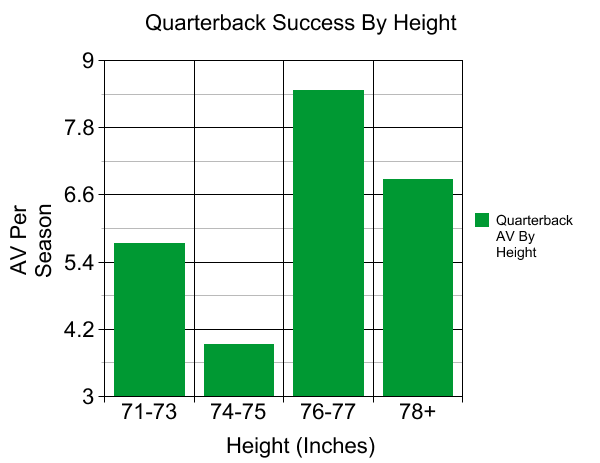In the 2001 NFL Draft, the Falcons traded up to draft Virginia Tech quarterback Michael Vick. At only 6-1, the Falcons were hoping Vick's rocket arm and blazing speed could make up for his relatively short stature. Later in the same draft, the Chargers hit it big (although they never realized it) on Drew Brees. Standing at the same height as Vick, Brees has relied on pinpoint accuracy to overcome being one of the shortest players at his position drafted in the last decade.
Recently, I've been attempting to determine which rookie traits best predict later NFL success. I focused on speed as measured by the 40-yard dash, finding that the metric really matters for running backs, sort of matters for receivers, and doesn't matter all that much for tight ends.
For quarterbacks, I decided to move away from studying speed because only recently has the NFL transitioned to a league in which mobile quarterbacks can be true difference-makers. Even during Vick's glory days in Atlanta, he was one of just a handful of passers to rely on his speed to make plays. With the NFL's adoption of the read-option and similar offensive styles, however, quarterback speed is now playing a major role in success at the position.
Instead of using speed, I charted the height of every quarterback (as measured at the Combine) drafted in the first two rounds from 2000 to 2010 (allowing a grace period to study their progression in the NFL). I analyzed only
In the 2001 NFL Draft, the Falcons traded up to draft Virginia Tech quarterback Michael Vick. At only 6-1, the Falcons were hoping Vick's rocket arm and blazing speed could make up for his relatively short stature. Later in the same draft, the Chargers hit it big (although they never realized it) on Drew Brees. Standing at the same height as Vick, Brees has relied on pinpoint accuracy to overcome being one of the shortest players at his position drafted in the last decade.
Recently, I've been attempting to determine which rookie traits best predict later NFL success. I focused on speed as measured by the 40-yard dash, finding that the metric really matters for running backs, sort of matters for receivers, and doesn't matter all that much for tight ends.
For quarterbacks, I decided to move away from studying speed because only recently has the NFL transitioned to a league in which mobile quarterbacks can be true difference-makers. Even during Vick's glory days in Atlanta, he was one of just a handful of passers to rely on his speed to make plays. With the NFL's adoption of the read-option and similar offensive styles, however, quarterback speed is now playing a major role in success at the position.
Instead of using speed, I charted the height of every quarterback (as measured at the Combine) drafted in the first two rounds from 2000 to 2010 (allowing a grace period to study their progression in the NFL). I analyzed only highly-drafted quarterbacks to make sure all of the subjects were on a relatively even playing field. To track success, I once again utilized approximate value per season. For the few quarterbacks who didn't start in their first NFL season, I disregarded every season up until their first start.
The Numbers

You can see the quarterbacks are pretty scattered, although there does appear to be a slight correlation between height and success. Interestingly, four of the six most successful first or second-round quarterbacks drafted since 2000—Philip Rivers, Matt Ryan, Ben Roethlisberger, and Eli Manning—all checked in at exactly 77 inches.
If we break down the result into group averages, the results become slightly clearer.

You see some success in the 71 to 73-inch group, but that's probably the result of a small sample size. Only five such quarterbacks were drafted in the first or second round between 2000 and 2010, and two of them were Vick and Brees. The fact that the AV-per-season drops for quarterbacks in the 74 to 75-inch group suggests the success of the shorter quarterbacks is a fluke. The success of the passers who stand 76 and 77 inches tall, on the other hand, is pretty remarkable.
Perhaps the best evidence that there's at least a small correlation between height and NFL production is the success rates for each group. Of the quarterbacks in this study who were measured between 71 and 75 inches, only 26.0 percent have posted at least 5.0 AV per season. Meanwhile, nearly three times as many quarterbacks who stand at least 76 inches tall—70.1 percent—have reached that mark.
Correlation vs Causation
The other day, I noticed that new Eagles head coach Chip Kelly mentioned that he doesn't necessarily care too much about height, but rather about hand size. Quarterbacks need to be able to control the football with ease, and big hands obviously allow for that.
That got me to thinking: could the success we see from tall quarterbacks not really be because they're tall, but because tall quarterbacks typically have bigger hands? A short quarterback with a larger-than-average hand size would then be predicted to have as much success as a taller quarterback with the same hand size, regardless of their difference in height. I'll need to run the numbers, but it's just something to consider as a potential explanation for the height/success correlation at the quarterback position.
Jonathan Bales is the author of Fantasy Football for Smart People: How to Dominate Your Draft. He also runs the "Running the Numbers" blog at DallasCowboys.com and writes for the New York Times.




























